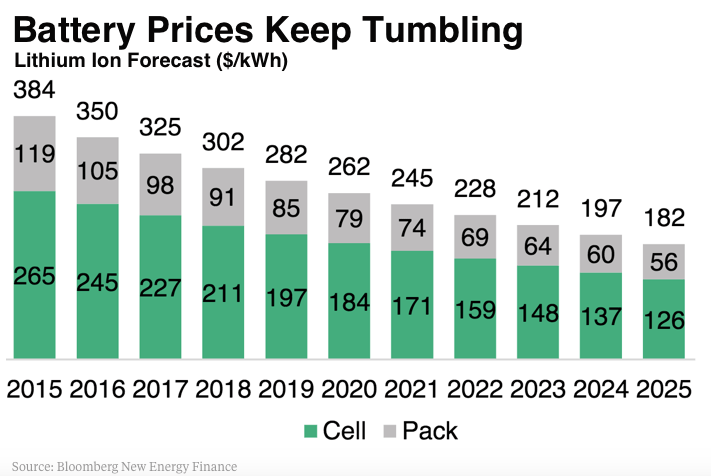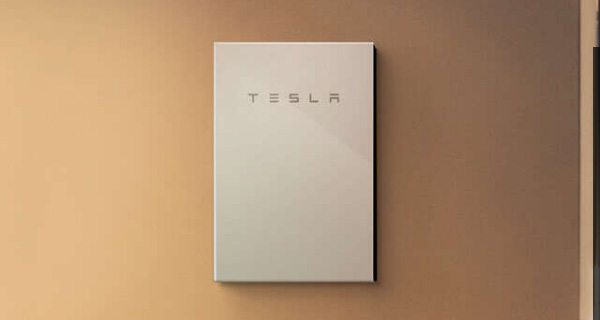The arrival of the Tesla Powerwall # 1 on the Australian market was a Really Big Deal. Here was our first glimpse at the home battery storage of the future: a sleek looking unit you could hang on your wall with pride; a badge of honour that said “I have taken charge of my power supply, hang the cost.”
But when the Powerwall 2 – pictured above – lands on Australian shores sometime in early 2017, it will be a Really Big Deal for a very different reason.
That is because, despite being more than double the capacity of the first Powerwall, and having an inverter built in, the 14kWh Powerwall 2 is nearly half the installed cost/kWh of its trail-blazing predecessor – making it less like the home battery storage of the future, and more like the home battery storage of the here and now.
And that really is a big deal. In fact, according to Bloomberg New Energy Finance, the Powerwall 2 just “may be the cheapest lithium ion battery for the home ever made when deliveries start in January.”
According to data compiled by BNEF, Tesla is selling its lithium-ion batteries at retail prices that are cheaper than the average manufacturing cost at most companies, setting a pace for the industry that is beating some of the most optimistic of price projections.
“We certainly expect it will move the market prices downwards as we saw last year with the first Powerwall’,” said Yayoi Sekine, a BNEF analyst who covers battery technology.
In Australia, that “Tesla effect” was making its mark on battery storage costs as early as June 2015, with prices of competing battery products falling by as much as one-third in just six months.
As we reported on RenewEconomy at the time, the 7.2kWh Power Legato system was being offered at around $A14,000, putting it at around $A2,020/kWh. The average pricing in November 2014 had been around $A3,200/kWh.

Basically, BNEF said in June 2015, Tesla’s first round of Powerwalls effected a price cut of around 50 per cent in $A terms. And for the other manufacturers to match that had meant sacrificing “R&D payback” in the first years of deployment.
The fact that Tesla has effectively done this again, not even 12 months after the first Powerwalls hit the market, reveals the kind of downward trajectory battery prices might be on, and the kind of pressure manufacturers will be under to cut costs and keep up with the Musks.
“The reduction per kWh of solar and of batteries is on a great trajectory,” said Chris Williams, the head of accredited Powerwall reseller Natural Solar. “Where the market is today, compared to where I thought it would be; I think we’re five or six years ahead,” he told One Step Off The Grid on Monday.
“There is a lot of satisfaction, for us, in being partnered with a company that is leading the way with innovation.”
But will it bring satisfaction for the customer? According to Williams, rooftop solar coupled with a Powerwall 2 could save the average Australian family of four save up to $1,500 on their annual energy bill.
Another accredited Tesla reseller, CSR Bradford, says its solar “ChargePack” including the new Powerwall “is capable of helping a family of five save over $2,000” on electricity annually.
Considering the Powerwall is expected to retail in Australia at around $8,800, for the battery alone that looks like about a four-year return on investment. If you’re adding solar, too, you can add another two years to that.
But assuming Powerwall 2 buyers will be as disinterested in ROI as Powerwall 1 buyers were, the real appeal could easily be the immediate cut in bill costs and grid dependence.
As we noted in our write-up on Monday, one Powerwall 2 is said to be capable of powering a two bedroom house for 24 hours, which puts the grid firmly in the position of being back-up.
For a four bedroom home, one Powerwall 2 should be able to get the household through the night on stored energy alone, thus cutting grid usage – and costs – to a bare minimum.
“This is the future for energy management,” said CSR Bradford head Anthony Tannous. “Control goes back to individual households enabling the homeowner to visibly see and control their energy usage – helping Australian families increase their independence from the grid and save thousands on their annual energy bill.”
Of course, not everyone will be celebrating the arrival of Powerwall 2. As Simon Hackett – the CEO of rival battery maker Redflow – has argued, Tesla’s addition of a built-in inverter has broader implications for the industry, and quite specific implications for invterter makers like Solar Edge and Fronius, who had partnered with Tesla on the rollout of the original Powerwall.
“The bottom line for the emerging energy storage sector is that each time Tesla sells a Powerwall 2 with integrated AC inverter, an existing inverter/charger/energy control system vendor books one less sale,” Hackett wrote in a blog on Monday.
“As a result, this new approach from Tesla may tend to polarise the market into two camps over time – with a distinct sensibility developing that is akin to the long-term battle of Apple vs Android in the smartphone market,” he says.
But Hackett, too, can see the upside: “Tesla’s presence in this market will drive increased interest in energy generation, storage and use,” he writes. “It will help to deliver further momentum to drive demand and adoption of energy storage systems in general.
“It will also act as a catalyst for other energy generation and storage systems – using a variety of technologies and deployed a variety of physical scales – to each find their own appropriate ‘place in the sun’.”
This article was originally published on RE sister site One Step Off The Grid. To sign up for the weekly newsletter, click here.









